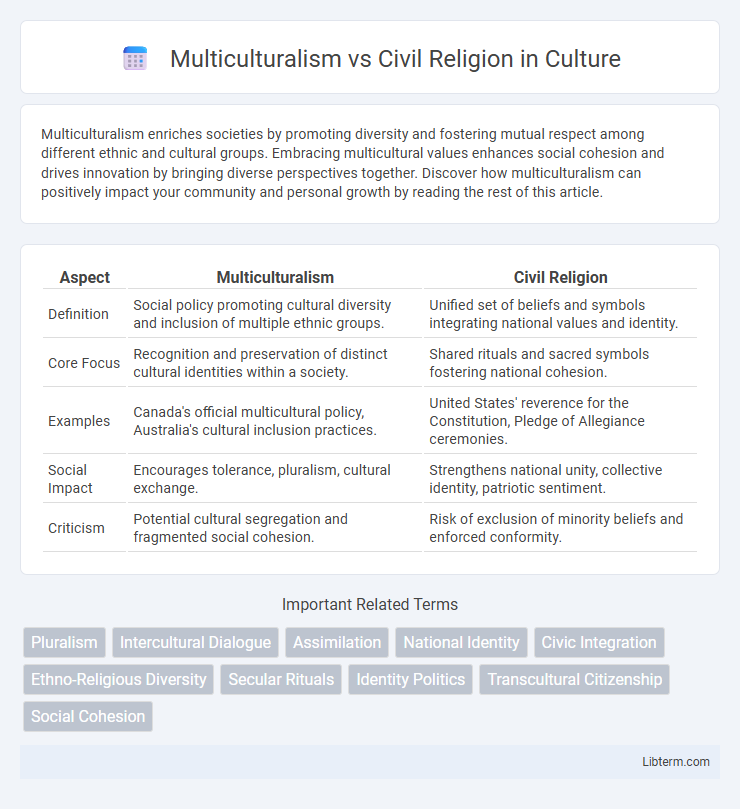Multiculturalism enriches societies by promoting diversity and fostering mutual respect among different ethnic and cultural groups. Embracing multicultural values enhances social cohesion and drives innovation by bringing diverse perspectives together. Discover how multiculturalism can positively impact your community and personal growth by reading the rest of this article.
Table of Comparison
| Aspect | Multiculturalism | Civil Religion |
|---|---|---|
| Definition | Social policy promoting cultural diversity and inclusion of multiple ethnic groups. | Unified set of beliefs and symbols integrating national values and identity. |
| Core Focus | Recognition and preservation of distinct cultural identities within a society. | Shared rituals and sacred symbols fostering national cohesion. |
| Examples | Canada's official multicultural policy, Australia's cultural inclusion practices. | United States' reverence for the Constitution, Pledge of Allegiance ceremonies. |
| Social Impact | Encourages tolerance, pluralism, cultural exchange. | Strengthens national unity, collective identity, patriotic sentiment. |
| Criticism | Potential cultural segregation and fragmented social cohesion. | Risk of exclusion of minority beliefs and enforced conformity. |
Understanding Multiculturalism: Core Principles and Goals
Multiculturalism emphasizes the recognition and celebration of diverse cultural identities within a society, promoting inclusion and equal respect for different ethnic, religious, and linguistic groups. Its core principles involve protecting cultural heritage while fostering social cohesion and mutual understanding. The goal is to create a pluralistic society where diversity strengthens democratic values and individual rights without imposing a singular civil religion or national identity.
Defining Civil Religion: Concepts and Characteristics
Civil religion refers to a set of sacred beliefs, symbols, and rituals that provide a collective religious dimension to the political life of a nation, transcending individual religious affiliations. It is characterized by the veneration of national history, founding figures, and moral values that unite diverse populations under a common identity. Unlike multiculturalism, which emphasizes cultural diversity and pluralism, civil religion promotes social cohesion through shared patriotic faith and public ceremonies.
Historical Context: Origins of Multiculturalism and Civil Religion
Multiculturalism emerged in the mid-20th century as a response to increasing ethnic diversity and immigration, emphasizing cultural pluralism and the recognition of minority rights within liberal democracies. Civil religion, rooted in the 18th and 19th centuries, particularly in the United States, combines nationalistic values with quasi-religious rituals and symbols to unify diverse populations under a shared set of beliefs and moral frameworks. The historical context reveals multiculturalism's focus on celebrating distinct cultural identities contrasts with civil religion's effort to create a cohesive national identity through collective rituals.
Social Integration: Approaches in Multiculturalism and Civil Religion
Multiculturalism promotes social integration through the recognition and celebration of diverse cultural identities, encouraging inclusion by valuing each group's unique contributions to society. Civil religion fosters social cohesion by emphasizing shared national symbols, rituals, and values that transcend individual differences, creating a unified collective identity. Both approaches aim to strengthen societal bonds but differ in their focus on pluralistic acceptance versus collective national belonging.
National Identity: Conflicts and Convergences
Multiculturalism emphasizes the coexistence of diverse cultural identities within a nation, often challenging the uniformity sought by civil religion's national identity, which relies on shared rituals and symbols to unify citizens. Conflicts arise when multiculturalism's recognition of distinct group identities appears to fragment the cohesive narrative promoted by civil religion. Convergences occur when inclusive civil religious practices incorporate pluralistic values, fostering a national identity that respects cultural diversity while maintaining collective belonging.
Policy Implications: Laws, Rights, and Public Life
Multiculturalism policies prioritize the protection of diverse cultural rights and promote inclusive public spaces, ensuring legal frameworks accommodate multiple identities and languages. Civil religion, by emphasizing a shared national ethos and rituals, influences laws that foster unity but may constrain the expression of minority cultural practices. Balancing these approaches requires crafting legislation that safeguards individual freedoms while encouraging collective participation in public life.
Education Systems: Shaping Values and Worldviews
Education systems play a pivotal role in shaping values and worldviews by either embracing multiculturalism, which promotes cultural diversity and inclusivity, or civil religion, which emphasizes shared national symbols and collective identity. Multicultural curricula encourage critical thinking about diverse perspectives, fostering tolerance and global awareness among students. Conversely, civil religion-oriented education reinforces social cohesion through patriotic rituals and narratives that cultivate loyalty to the nation-state.
Challenges and Criticisms: Tensions and Limitations
Multiculturalism faces challenges in balancing diverse cultural identities with social cohesion, often criticized for fostering segregation and undermining shared values. Civil religion, while promoting national unity through common symbols and rituals, can marginalize minority beliefs and ignore cultural pluralism. Both frameworks struggle with tensions between inclusivity and maintaining a cohesive societal identity, highlighting limitations in addressing the complexity of modern, diverse populations.
Case Studies: Real-World Examples of Multiculturalism and Civil Religion
Case studies of multiculturalism include Canada's policy of official bilingualism and multiculturalism, which promotes cultural diversity and inclusion within a unified national identity, and Singapore's maintenance of ethnic harmony through legal frameworks supporting racial and religious tolerance. In contrast, civil religion is exemplified by the United States, where rituals like presidential inaugurations and national holidays embody shared values and patriotism, uniting diverse groups under a common set of beliefs. France's laicite serves as a form of civil religion by enforcing secularism, which shapes national identity by subordinating religious expression to the principles of the republic.
Future Prospects: Balancing Diversity and Unity
Future prospects in multiculturalism versus civil religion hinge on achieving a balance between cultural diversity and social cohesion. Emphasizing inclusive civil religious symbols can foster unity while respecting distinct cultural identities. Innovative policies that promote intercultural dialogue and shared values are essential for sustaining this balance in increasingly pluralistic societies.
Multiculturalism Infographic

 libterm.com
libterm.com